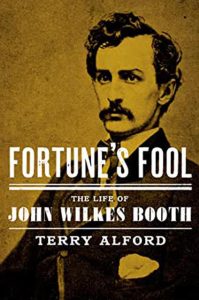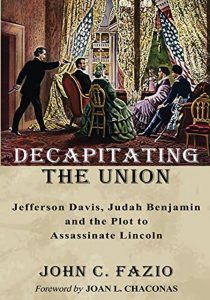Was John Wilkes Booth a ‘Patsy’ in the Murder Plot to Kill Abraham Lincoln?
“And you shall know the truth, and the truth shall make you free.” – Saint John the Evangelist
Who can forget the last words of John F. Kennedy’s alleged assassin, Harvey Lee Oswald? On November 22, 1963, just two days before his killer Jack Ruby shot him dead in the basement of the Dallas police station, Oswald declared: “I’m a patsy!” (1)
Who was Ruby? He was a sleazy strip club owner, with ties to both the Dallas and Chicago Mobs. He later died in prison. Ruby pointed to the then-President Lyndon B. Johnson, as the man behind the scenes who orchestrated the hit job on J.F.K. (2)
Recently, three books have been published that also claim, with strong documentation, it was Johnson who was the power behind the conspiracy to kill Kennedy. LBJ was described as a “loutish psychopath willing to do anything to advance his rise to power.” The books further revealed: “Oswald was a CIA pawn, set up to be the fall guy…and that he personally knew Jack Ruby.” (3)
Another case that fits into the “patsy” category of the JFK killing was the murder of the Civil Rights icon, Martin Luther King, Jr., in Memphis, TN, on April 4, 1968. The man set up to take the fall for that killing was one James Earl Ray. King’s family believed Ray was framed, as did King’s close friend, Andrew Young. (4)
Then, there is JFK’s younger brother, Robert. He was assassinated on June 5, 1968, in Los Angles. Supposedly, his killer was Sirhan Sirhan. Kennedy’s oldest son, RFK, Jr., however, among others, doesn’t believe it. He wants the case reopened. (5)
Harvey Lee Oswald, James Earl Ray, and Sirhan Sirhan are three examples that describe the word – patsy. But, even a known, confessed assassin can also be a patsy if he wasn’t aware who was really pulling the strings behind his foul deed.
(In other words, the killer is ignorant of the fact he was being manipulated by an individual or group higher up the chain of command. Let’s call this group the “Wirepullers.” For their own reasons – they – wanted the target dead. They also didn’t want the killer (their patsy/stooge) to know of their role in conceiving of the crime and/or their identity, especially in case the plot backfired.)
 Enter John Wilkes Booth!
Enter John Wilkes Booth!
Most of his story is well known. Booth (1838-65) was a talented 26-year-old actor. At the time of his death, he called Bel Air, Maryland, home. His family was prominent in the acting profession. He was a Confederate sympathizer but declined to join its Army. Instead, he secretly became part of a plot to kidnap Lincoln. It later evolved into a murder conspiracy.
Also targeted in this vile killing scheme were other key leaders of Lincoln’s government. On April 12, 1865, Booth heard the news that Confederate General Robert E. Lee had surrendered his army. Nevertheless, Booth pushed ahead with the off-the-wall killing plan. On April 14, he went to Ford’s Theatre, in D.C., and shot the president in the back of the head. Lincoln died the next morning.
Twelve days later, Booth was tracked down to a farm in rural Virginia where he was shot and killed. Of the known eight Booth co-conspirators, four were quickly hanged.
For an account of Booth’s background, with details on all of the major players in this reckless crime, I recommend “Fortune’s Fool: The Life of John Wilkes Booth,” by Terry Alford.
But, if you’re like me and you want to learn the deeper truths about Booth, and all the intrigues related to Lincoln’s murder, then check out: “Decapitating the Union: Jefferson Davis, Judah Benjamin, and the Plot to Assassinate Lincoln,” by John C. Fazio.
Fazio is convinced that the hedonistic “Booth was just a pawn,” and a two-bit actor in this great drama. He showed how the young hot-head and upstart, often drunk, was recruited by the Confederate Secret Service (CSS), headed by Davis, and his alter ego, Benjamin. Booth, among other flaws, was a flaming bigot, he hated Blacks and considered slavery as a “great blessing.” It isn’t any surprise to find out, too, that the egomaniac Booth was also a card-carrying member of the viciously anti-Catholic “No Nothing Party.” The author documented how the wind-bag actor was “regularly in touch” with agents of the CSS both in this country and Canada.
Booth’s own sister, Asia, referred to him as “a spy, blockade runner, and a rebel.” A head case, he was also known to down a “bottle of brandy,” in one sitting. Keep in mind, the author underscored, that Booth, before this case, “had never killed anyone in his life.”
Fazio is convinced that Booth was incapable of putting together such a complicated, wide-spread, killing scheme, which targeted not only the president, “but four more at least.” The list included: Vice-President Andrew Johnson; Secretary of State William Seward; Secretary of War Edwin Stanton and Lt. General Ulysses G. Grant.
 Fazio’s bottom line: Booth was a patsy for the Confederate Secret Service!
Fazio’s bottom line: Booth was a patsy for the Confederate Secret Service!
As for Booth’s “Wirepullers” in the Confederate Secret Service, Davis, and Benjamin, they both got out of Dodge fast when the Confederacy collapsed. Each of these Slavocrats had owned large estates with hundreds of blacks laboring away on them.
Jefferson Davis, the President of the Confederacy, (a former U.S. Senator from Mississippi), was quickly captured near Irvinville, Georgia, supposedly “in women’s clothes.” (6) He was charged with Treason and spent two years in a federal slammer. Lucky for him, the case was eventually dropped.
Meanwhile, the cunning Benjamin, then-Secretary of State of the Confederacy, (a former U.S. Senator from Louisiana), made it safely to England, where he became – a barrister! He died in Paris, in 1884, at the age of 72.
Like fleeting criminals before them, both Davis and Benjamin, as if on cue, had fled the scene of their dastardly crime. They had also destroyed all their private and public papers before running for cover. Their actions raised a strong inference of guilt.
All the above made me wonder, did either Davis or Benjamin ever have any regrets about their responsibility for the 620,000 brave, dead soldiers that they left behind on the blood-soaked Civil War battlefields of America?
Notes:
- https://www.youtube.com/watch?
v=sbR6vHXD1j0 and https://historycollection.co/ wasnt-oswald-killed-jfk-part- 2-6-reasons-oswald-not-killer/ 6/ - http://jfkmurdersolved.com/
ruby.htm - http://www.renewamerica.com/
columns/lukens/140331. - https://www.washingtonpost.
com/news/retropolis/wp/2018/ 03/30/who-killed-martin- luther-king-jr-his-family- believes-james-earl-ray-was- framed/. - https://www.washingtonpost.
com/news/retropolis/wp/2018/ 05/26/who-killed-bobby- kennedy-his-son-rfk-jr-doesnt- believe-it-was-sirhan-sirhan/ - https://ss.sites.mtu.edu/
mhugl/2017/10/24/capture-of- jefferson-davis-by-the-fourth- michigan/.
Feature photo: John Wilkes Booth – Library of Congress. U.S. Public Domain.

Bill Hughes is an attorney, author, actor and photographer. His latest book is “Byline Baltimore.” It can be found at: https://www.amazon.com/William-Hughes/e/B00N7MGPXO/ref=dp_byline_cont_book_1

